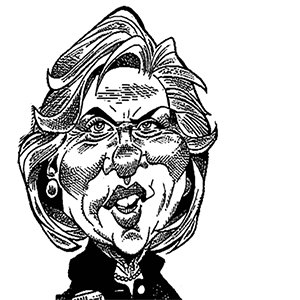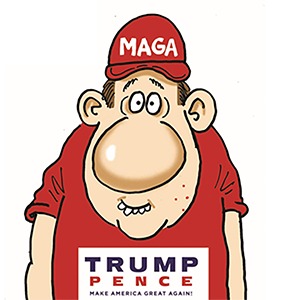Stocks hit by dizzying swings as bond yields surge: Markets wrap
Published in News & Features
Waves of volatility shook markets anew, with stocks, bonds and commodities getting whipsawed by another deluge of headlines around President Donald Trump’s trade war that only reinforced the clouds hanging over the outlook for investing and the economy.
Traders looking for equities to snap back after a selloff of trillions of dollars were faced with a series of twists and turns on Monday. While the S&P 500 moved away from the threshold of a bear market, its bottom-to-top intraday reversal was the biggest since 2020 when Covid upended global trading. Treasuries weakened, with yields across all maturities higher by over 10 basis points — a stark turnaround from the plunge earlier in the day.
Trump noted he wasn’t considering a pause on his plan to implement additional tariffs on dozens of countries, while still signaling he could be open to negotiations. Treasury Secretary Scott Bessent said that perhaps almost 70 countries have already approached the U.S.
Subscribe to the Stock Movers Podcast on Apple, Spotify and other Podcast Platforms.
As markets wobbled, some Wall Street titans sounded the alarm. Bill Ackman said the U.S. is “heading for a self-induced, economic nuclear winter.” Boaz Weinstein predicted the “avalanche has really just started.” And Jamie Dimon said it “may be disastrous in the long run.”
“For now, it looks like news out of Washington will continue to drive the market’s swings, one way or the other,” said Chris Larkin at E*Trade from Morgan Stanley. “Some of the market’s notable lows over the past few decades have been preceded by similar levels of volatility, although it’s always impossible to know when prices will eventually find their bottom.”
To Matt Maley at Miller Tabak, those looking for a V-shaped recovery in the stock market will likely be very disappointed.
“We should see a strong bounce at some point soon, but the process of repricing the market to its realistic economic outlook will take time,” Maley said. “There will be plenty of time to get aggressive when it becomes more evident that the worst of the decline is behind us.”
“Despite the nausea-inducing gyrations, the stock market managed to avoid closing in bear-market territory,” said Greg McBride at Bankrate. “We may not have yet reached the bottom, but a day like today at least gives you some confidence that we could be close.”
HSBC strategist Max Kettner is making the case for a “very short-term bounce” in stock markets, with the Magnificent Seven possibly benefiting the most. However, any rebound will only set the stage for another leg lower, he warns. To Morgan Stanley’s Michael Wilson, investors should be prepared for the S&P 500 to drop further if tariff angst doesn’t subside.
“Many metrics are at panic levels associated with meaningful bottoms over the past 40 years,” said Jonathan Krinsky at BTIG. “The issue is when you get into the capitulation zone, markets often move beyond what many think is likely or possible.”
Besides breadth and sentiment indicators reaching extremes that have been associated with prior market lows, many are keeping a close eye on Wall Street’s favorite measure of equity swings.
The VIX pushed away from the 60 mark hit earlier Monday, but major stock selloffs have typically reached their culmination amid a level of fear that hasn’t yet been hit.
The index topped out at nearly 66 in August during the market rout sparked by the unwind of the Japanese yen carry trade and recession jitters, and it hit 85 in the 2020 selloff fueled by Covid. In 2008, it rocketed to just short of 90 as worries over the great financial crisis hammered stocks.
“It is worth remembering that this market shock happened as the result of a surprising change in policy – not a fundamental breakdown in a key sector, such as housing in 2008 or tech in 2000,” said Carol Schleif BMO Private Wealth.
“It will be tough for markets to move upward until policy relief is clearer,” Schleif said. “In the near term, non-U.S. markets, fixed income and non-correlated asset classes may continue to provide ballast in an investment portfolio. In the intermediate- and longer-term, we do suspect the U.S. economy can prove resilient even if growth slows for a period.”
One silver lining is that the so-called smart money might be getting close to a tactical bottom.
Hedge funds increased short positions across a range of U.S. macro products by 22% last week, marking the largest jump in more than a decade, wrote Vincent Lin at Goldman Sachs Group Inc.
What lingers as a big risk, though, is that the retail crowd hasn’t sold U.S. equities meaningfully, presenting an additional risk to the stock market.
“You’ll hear all sorts of opinions as to when and where the market will bottom out, but they’re all guesses,” Bespoke Investment Group strategists noted. “No one knows at this point.”
The selloff has taken U.S. equity valuations to the lowest level since late 2023, but that’s not a solid argument at this stage for many traders.
“Markets won’t rebound until tariffs are negotiated and reduced, until valuations move even lower to very compelling levels, and until fundamentals improve, and none of these factors are in the cards at this time, said Richard Saperstein at Treasury Partners.
To Larry Tentarelli at the Blue Chip Daily Trend Report, investors should maintain defensive positioning, above average cash levels, and reduced if any new buying until volatility comes down.
“Market direction will be based on the tariff news cycle to start the week,” he said. “If there is a material, positive change in the news cycle, markets could benefit. Until then, continue to expect very wide trading ranges.”
Wall Street forecasters are racing to temper their views on U.S. equities as Trump’s sweeping tariffs threaten to upend the global economy.
JPMorgan Chase & Co.’s Dubravko Lakos-Bujas slashed his year-end forecast for the S&P 500 to 5,200 from 6,500 previously. Oppenheimer & Co.’s John Stoltzfus — the biggest bull among strategists until March — cut his outlook to 5,950 points from 7,100. Strategists at Evercore ISI, Goldman Sachs. and Societe Generale SA have also reduced targets in recent days.
“Our base case is that after an initial phase in which tariffs could rise further, U.S. effective tariff rates should start to come down from 3Q,” said Solita Marcelli at UBS Global Wealth Management. “We also expect the Fed to cut interest rates by 75-100 basis points to support the economy. In this scenario, we believe the S&P 500 can recover to 5,800 by year-end.
Traders’ bets on how much the Federal Reserve will lower interest rates in 2025 fluctuated between three and five quarter-point cuts. Four reductions are now reflected in overnight interest-rate swaps this year, with the first fully priced in for June. A May reduction is seen as a coin toss.
With inflation still running above the U.S. central bank’s target and levy-induced price hikes on the horizon, economists and market analysts said they believe Fed officials will wait for the impact to hit the real economy before they lower interest rates. That could take months to show up in official data.
“If we don’t get a recession, it’s going to be hard for the Fed to look through this inflation in the short run,” Michael Gapen, chief U.S. economist for Morgan Stanley said Monday on Bloomberg Television. “The Fed’s going to be on hold for the foreseeable future.”
Some of the main moves in markets:
Stocks
—The S&P 500 fell 0.2% as of 4 p.m. New York time
—The Nasdaq 100 rose 0.2%
—The Dow Jones Industrial Average fell 0.9%
—The MSCI World Index fell 1.8%
Currencies
—The Bloomberg Dollar Spot Index rose 0.6%
—The euro fell 0.4% to $1.0914
—The British pound fell 1.4% to $1.2712
—The Japanese yen fell 0.8% to 148.09 per dollar
Cryptocurrencies
—Bitcoin fell 0.8% to $78,160.98
—Ether fell 1.8% to $1,546.16
Bonds
—The yield on 10-year Treasuries advanced 22 basis points to 4.22%
—Germany’s 10-year yield advanced three basis points to 2.61%
—Britain’s 10-year yield advanced 17 basis points to 4.61%
Commodities
—West Texas Intermediate crude fell 1.6% to $60.99 a barrel
—Spot gold fell 2.2% to $2,970.77 an ounce
(With assistance from Robert Brand, Julien Ponthus, Anand Krishnamoorthy and Richard Henderson.)
©2025 Bloomberg L.P. Visit bloomberg.com. Distributed by Tribune Content Agency, LLC.







Comments